Posts Tagged ‘innovation’

Uber marketing mix (Uber 7Ps of marketing) comprises elements of the marketing mix that consists of product, place, price, promotion, process, people and physical evidence. Product Element in Uber Marketing Mix (Uber 7PS of Marketing) Uber is a service company and it does not sell products. Uber has clear advantages over regular taxi. These include clear overview of pricing prior to booking, one-tap rides, following drivers on map, cashless convenience and fare splitting, as well as feedback options. The range of services offered by Uber with brief descriptions is illustrated in table below: Service Descrption X Low cost option for the passengers looking for low cost rides for up to 4 riders XL Low cost option for the passengers looking for low cost rides for up to 6 riders Pool Car sharing: riders can bring one other person with them, thus saving on travel costs GO Ride in a hatchback Comfort Newer cars with extra legroom Flash Match with closest Uber Taxi or UberX AUTO Ride in Auto rickshaws, currently available in Bangalore and Pune only Access Taxi service with wheelchair access to cater to the need of elderly and people with disabilities. MOTO Booking bike rides around the city Premium A fleet of stylish vehicles to choose from. Uber Premium comprises Uber SELECT, Uber BLACK, Uber SUV and Uber LUX Green Sustainable rides in electric vehicles Scooters Electric scooters to help people to get around a city Transit Real-time public transit information in the Uber app WAV Rides in wheelchair-accessible vehicles RUSH Courier Package Service EATS Allows customers to order food on the go Uber services and descriptions Place Element in Uber Marketing Mix (Uber 7PS of Marketing) Uber is available in 71 countries around the globe.[1] The service has a high level of geographic concentration. In…

Uber marketing strategy integrates print and media advertising, sales promotions, events and experiences, public relations and others. Particularly, Uber marketing strategy is mainly based on the word-of-mouth. Moreover, media in general and social media in particular play instrumental roles in terms of increasing the levels of Uber brand awareness in the global scale. At the same time, it is important to note that during the past few years, Uber-related messages communicated by the media have been mainly focused on scandals involving Uber, thus damaging the company’s brand image. Uber sales and marketing costs amounted to USD 3,58 USD 4,63 and USD 3,15 billions in 2020, 2019 and 2018 respectively.[1] Uber’s “rider-focused ad spend has increased twentyfold in the last year and a half.”[2] However, Chief Operating Officer Barney Harford has announced his plans to decrease marketing expenses as part of his attempts “bring a dose of financial discipline.”[3] Uber 7ps of marketing focuses on product and price elements of the marketing mix to a greater extent compared to other elements. Specifically, the global transportation technology company is increasing the range of its services to target greater numbers of customer segments. At the same time, the majority of Uber services are cheaper than traditional taxi, illustrating company’s focus on cost element of the marketing mix. Uber’s unique selling proposition is associated with cost efficiency, increasing service range and high level of customer convenience. Particularly, customers greatly appreciate convenience aspect of Uber value proposition. Accordingly, the global transportation technology company targets wide customer segment in terms of geographical location, age, social status and other criteria. Uber Technologies Inc. Report contains the above analysis of Uber marketing strategy. The report illustrates the application of the major analytical strategic frameworks in business studies such as SWOT, PESTEL, Porter’s Five Forces, Value Chain…

SWOT is an acronym for strengths, weaknesses, opportunities and threats related to organizations. The following table illustrates Uber SWOT analysis: Strengths 1. First mover advantage and global market leadership 2. Low operational costs 3. Effective implementation of ‘Think Global, Act Local’ strategy 4. Uber ecosystem 5. High levels of user convenience Weaknesses 1. Damaged brand image due to a series of various scandals 2. Increasing losses of the business 3. Uber business model is easy to imitate 4. Only technically savvy individuals can use Uber services 5. Low earnings by Uber drivers Opportunities 1. Increasing popularity of sharing economy 2. Self-driving cars 3. Improving brand image through CSR programs and initiatives 4. Increasing internet penetration in the global scale 5. Increasing service range Threats 1. More legal actions in certain countries to ban Uber from operating 2. Further intensification of competition 3. The risk of new scandals and ethical issues 4. Growing protests and retaliations from traditional taxi services 5. Drivers leaving Uber due to low earnings Uber SWOT analysis Strengths in Uber SWOT Analysis 1. Uber is the largest global taxi technology company in the world and it has a first mover advantage in the ride-hailing segment in the global scale. The company has effectively utilised its fist mover advantage to build momentum and achieve global expansion in a short period of time. Moreover, thanks to first-mover advantage, the word Uber has become synonym for ride-haling internationally and the new term uberisation has emerged describing commodisation of various services. Uber is an undisputed market leader in ride-haling the global scale. The largest mobility platform in the world has more than 93 million monthly active riders in approximately 10000 cities worldwide. As illustrated in figure below, Uber is much more popular than its closest rival Lyft in the largest…
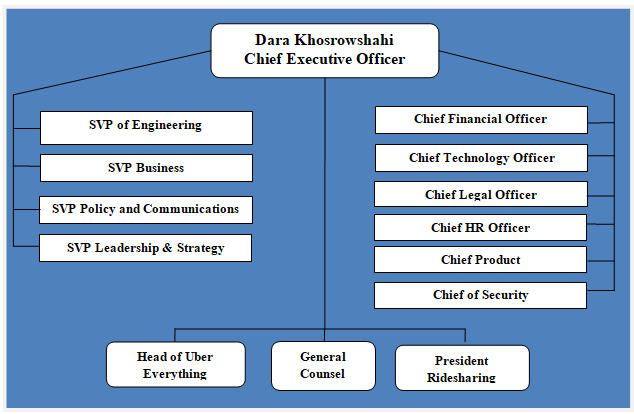
Uber organizational structure has been traditionally highly hierarchical with co-founder and former CEO Travis Kalanick yielding tremendous power and micromanaging the ride-hailing giant. Lack of Kalanick’s leadership skills resulted in a series of scandals involving bullying, discrimination at workplace, sexual harassment etc. Kalanick had to resign as a result of these scandals. After Dara Khosrowshahi became new CEO in 2017, Uber organizational structure has been subjected to certain changes.[1] Figure below illustrates Uber organizational structure: Uber Organizational Structure It can be argued that the current pattern of Uber’s organizational structure illustrated in Figure 1 above can be subjected to more changes by new CEO Dara Khosrowshahi in the medium-term perspective. Demoralized workforce and poor organizational culture belong to the list of major issues for the global transportation technology company. Dara Khosrowshahi is credited for creating collaborative work culture at Expedia where employees are encouraged to propose their ideas to management. Mr. Khosrowshahi is attempting to fix Uber organizational culture as part of his grand plans to turnaround the business. Accordingly, improvement in organizational culture may necessitate changes in organizational structure. Specifically, de-layering of organizational structure may be introduced, removing certain levels of management in order to make the business more flexible to respond to the changes in external marketplace. Moreover, advantages of flat organizational structure include faster speed of communication between the top management and floor-level employees. Senior leadership reorganization initiated by CEO Dara Khosrowshahi due to failed IPO in 2019 the roles of chief operating officer (COO) and chief marketing officer (CMO) were eliminated. Specifically, COO role was replaced by two executives who manage biggest businesses – ride-haling and food delivery. These two executives directly report to Khosrowshahi. Uber marketing operations, on the other hand, were combined with communications and policy departments. The rationale behind this specific change was…

Tesla CSR programs and initiatives are currently led by Vice President of People Valerie Chapman. Tesla did not pay due attention to social responsibility aspect of the business and did not engage in corporate sustainability reporting for a long time. Although the electric automaker was founded in 2003 and became publicly traded company in 2010, the company released its first CSR report titled Impact Report only in 2018. The alternative fuel vehicles manufacturer has Diversity, Equity and Inclusion (DEI) team that uses data-driven approach to champion diversity, equity and inclusion in business practices and communities.[1] Tesla produces electric vehicles, energy storage systems and solar panels. These products are perceived to promote environmental sustainability and this perception is effectively integrated into company’s marketing communication message. Tesla CSR Programs and Initiatives Employee Health and Safety at Tesla Production employees are required to participate in a multi-day training program before ever setting foot on the factory floor. Tesla provides zero-cost health care and benefits to full-time employee positions. Employee engagement in health risk reduction measured by employee suggestions, good observations, Find it-Fix it program and continuous improvement ideas have increased from 3,000 engagements in 2017 to almost 23,000 in 2019. Tesla and Gender Equality and Minorities Tesla was recognised as Best Employer for Diversity in 2019 by Forbes The electric car maker attempts to ensure a fair representation of traditionally underrepresented communities among its workforce. As it is illustrated in Figure 1 below, traditionally underrepresented groups amount to the majority 60% at Tesla. Figure 1 Underrepresented communities representation at Tesla US Traditionally underrepresented communities are also present in Director and Vice President positions at Tesla, as illustrated in Figure 2 below. Figure 2 Underrepresented communities in leadership positions at Tesla US Gender representation is an issue at Tesla. Only 21% of US…
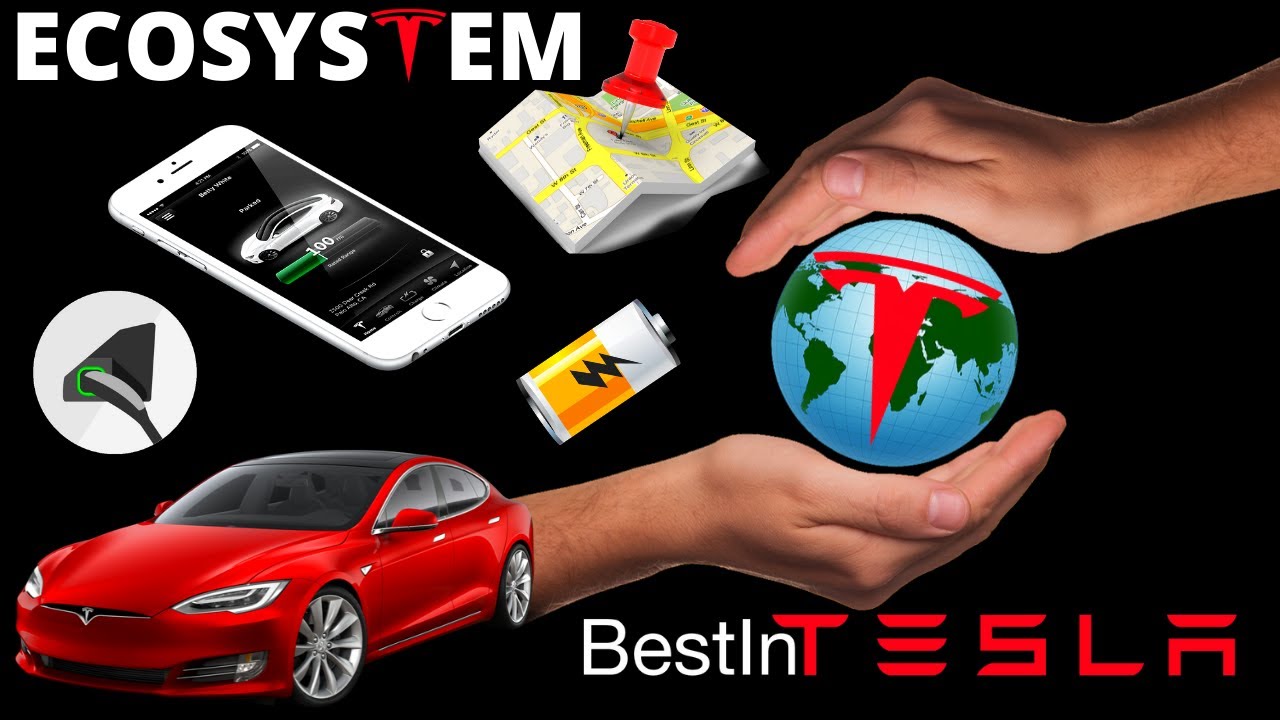
Tesla ecosystem at the moment comprises electric vehicles, charging infrastructure and solar systems. Energy solution products such as Powerwall, Powerpack and Solar Roof, enable homeowners, businesses and utilities to manage renewable energy generation, storage, and consumption. The following are important considerations related to Tesla ecosystem: 1. Tesla mobile app is the linking point of various elements of its ecosystem. Although Tesla ecosystem is rather small at present, nevertheless, it is highly sophisticated. Tesla mobile app provides customers control over many features of cars. The same app is also used to control solar panels and Powerwall so that customers have power flow detail and control in a single place.[1] The alternative fuel vehicles manufacturer can integrate additional range of products and services into the same app to further strengthen Tesla ecosystem. 2. Supercharging networks are competitive advantage and important element of Tesla’s ecosystem. Unlike its competitors, Tesla heavily invested in developing and spreading its supercharging networks from the early stages of its business operations. Currently, Tesla has more than 20,000 Superchargers globally, which is unparalleled in electric auto industry. Growing numbers of charging stations strengthens ecosystem of Tesla and creates solid foundation for long-term growth of the business. 3. Immense potential for development. There is a consensus among industry analysts about immense potential of Tesla ecosystem. Analysts forecast that “the electric vehicle will not be simply a plug-in replacement for the legacy gas-burner, but rather a part of a new paradigm that includes charging infrastructure, vehicle autonomy, new ownership models and renewable energy.”[2] Moreover, self-driving cars are widely seen as inevitable future of transportation for medium to long-term prospects. There are differences in strategies of leading market players to establish their firm presence in self-driving segment. On one hand, companies such as Alphabet Inc.’s (Google) and Apple are seeking to form…
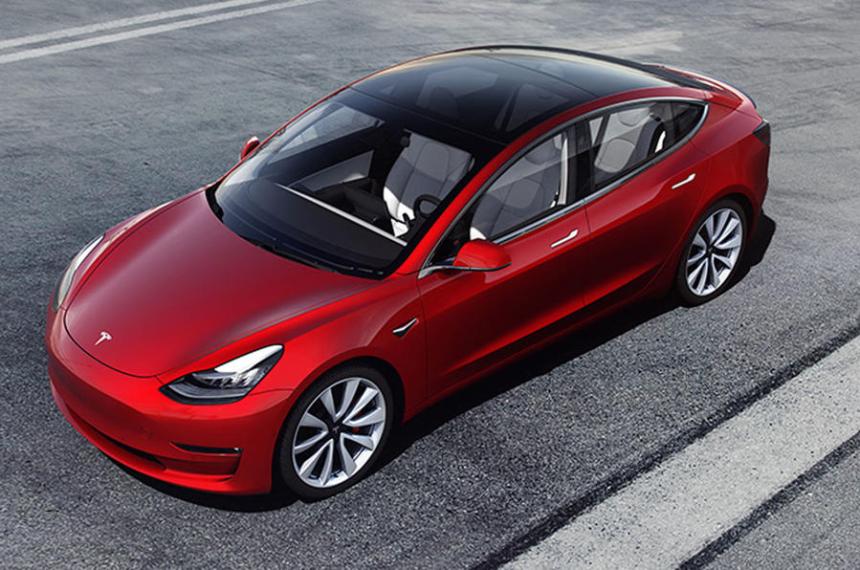
Tesla segmentation, targeting and positioning is a chain of activities that involves identification of a specific population segment(s) and developing products to cater for the needs and wants of consumers belonging to the segment(s). Segmentation involves dividing population into groups according to certain characteristics such as age, social status, psychological characteristics etc. Targeting implies choosing specific groups (segments) identified as a result of segmentation to sell products to. Positioning is the selection and application of the marketing mix the most suitable for the target customer segment. Tesla uses mono-segment positioning. Accordingly, the alternative fuel vehicles manufacturer targets individuals concerned with negative environmental implications of oil and gas consumption. Tesla products are considered to be expensive for average consumers and thus, the target customer segment for the company is wealthy individuals and households. At the same time, Tesla may switch from mono-segment to multi segment type of positioning in the foreseeable future. According to Tesla business strategy announced by Elon Musk in a blog post in 2006, the company builds sports car, uses that money to build an affordable car and uses that money to build an even more affordable car. [1] Tesla also uses anticipatory type of positioning. Specifically, the electric automaker positions its products and services for a market segment that has low turnover with the anticipation that the turnover will increase in the future. The electric automaker’s energy storage products such as Powerwall 2 and Powerpack 2 can be mentioned as examples for anticipatory positioning. The following table illustrates Tesla segmentation, targeting and positioning: Type of segmen-tation Segmen-tation criteria Tesla target customer segment Vehicles: Model S, Model X, Model 3, Future Consumer and Commercial Evs Energy storage: Powerwall 2, Powerpack 2 Solar energy systems: solar panels, inverters, racking, electrical hardware, monitoring device Geog-raphic Region North America,…
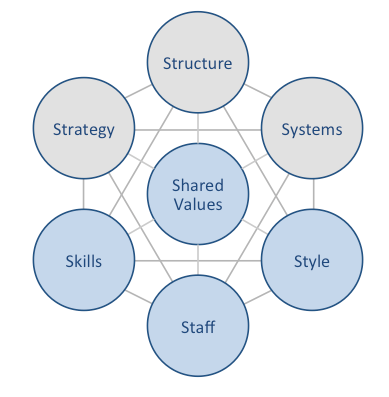
Tesla McKinsey 7S model illustrates the ways in which seven elements of businesses can be aligned to increase effectiveness. According to the framework strategy, structure and systems are considered as hard elements, whereas shared values, skills, style and staff represent soft elements. McKinsey 7S model stresses the presence of strong links between elements. Specifically, according to this framework, a change in one element causes changes in others. As it is illustrated in figure below, shared values are positioned at the core of Tesla McKinsey 7S model, since shared values guide employee behaviour with implications on their performance. Figure 11 McKinsey 7S model Hard Elements Strategy Tesla business strategy is based on the focus on electric cars driven by company’s mission to accelerate the world’s transition to sustainable energy. The alternative fuel vehicles manufacturer pursues product differentiation business strategy. Tesla cars and energy products are differentiated on the basis of performance, design and environmental sustainability. Moreover, ownership of distribution via company-operated stores and galleries in shopping centres and other places is placed at the core of Tesla business strategy. Moreover, the alternative fuel vehicles manufacturer positions low costs of Tesla electric vehicles ownership as one of the solid bases of competitive advantage. Structure It is difficult to classify Tesla organizational structure into a single category due to its unique nature. Inability or unwillingness of CEO Elon Musk to delegate key tasks has certain implications on organizational structure of the company. Specifically, Musk has more people directly reporting to him than any other auto company and turnover amongst Tesla senior executive team is high. Moreover, there is no organizational chart or public list of senior leaders at Tesla. Nevertheless, Tesla organizational structure is closer to divisional structure compared to other known structures. The operations of the electric automaker are divided…
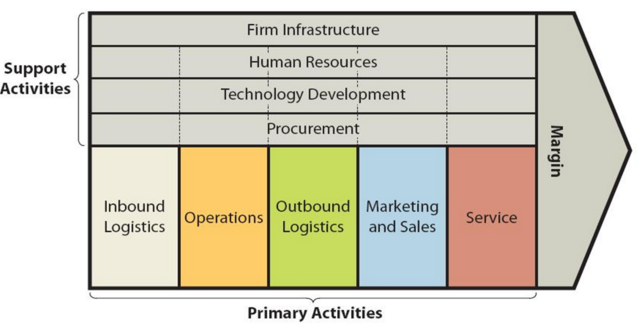
Tesla value chain analysis is an analytical framework that assists in identifying business activities that can create value and competitive advantage to the electric automaker. Figure below illustrates the essence of Tesla value chain analysis. Tesla value chain analysis Primary Activities in Tesla Value Chain Analysis Tesla Inbound logistics Tesla inbound logistics involves the receipt and storage of raw materials to build electric vehicles, energy storage systems and solar panels. Along with a standard set of raw materials, Tesla uses a range of scarce materials such as aluminium, steel, cobalt, lithium, nickel and copper. In the US, the company receives parts at its Fremont automotive factory from thousands of suppliers worldwide, including from its very own Gigafactory in Sparks, Nevada. The electric automaker leases three warehouses totalling a massive 1.3 million square feet in the Oaks Logistics Centre in Livermore, California., just 20 miles northeast of the Fremont factory as a storage for raw materials. Additionally, in 2019, Tesla constructed 870,000-square-foot facility in Lathrop, California as a massive spare parts storage.[1] Currently, highly sophisticated inbound logistics practices are not one of the main sources of value creation for the electric automaker. Tesla works primarily on a build-to-order basis, which means bottlenecks in parts supply could be a big headache.[2] Accordingly, it is critically important for Tesla to establish long-term strategic relationships with suppliers. Tesla Operations Tesla conducts vehicle manufacturing and assembly operations at its facilities in Fremont, California; Lathrop, California; Tilburg, Netherlands and Shanhhai, China. Generally, Tesla operations can be divided into two segments: 1. Automotive. This segment comprises design, development, manufacturing, and sales of electric vehicles. The company produced and delivered approximately half a million vehicles in 2020.[3] The electric automaker started Model Y production at Gigafactory Shanghai in December 2020. The table below illustrates annual production capacities…
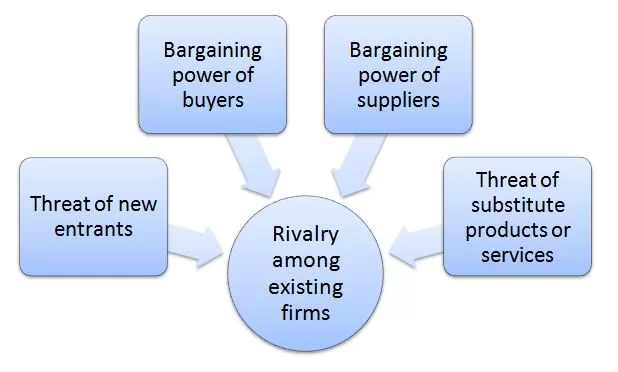
Porter’s Five Forces analytical framework developed by Michael Porter (1979)[1] represents five individual forces that shape an overall extent of competition in the industry. Tesla Porter’s Five Forces Analysis below contains the application of these factors to analyse the competitive environment for the alternative fuel vehicles manufacturer. Figure 1 Porter’s Five Forces Threat of new entrants in Tesla Porter’s Five Forces Analysis The threat of new entrants into alternative fuel vehicles manufacturing industry is moderate. The following factors play an instrumental role in the formation of threat of new entrants into electric vehicles industry: 1. Compromise between performance and cost of electric vehicles. One of the major challenges for electric vehicles is the bargain or compromise between their performance and cost. On one hand, almost all major automakers such as General Motors, Ford, Toyota, BMW and others have built electric cars that are not very expensive, but performance of these cars are compromised. Specifically, electric cars were known for being slower compared to traditional cars and their batteries did not last for long. On the other hand, Tesla has been able to develop its Model S, Model X and Model 3 cars that are fully electric and boasts with advanced technical characteristics such as high speed and long milage in a single charge. However, such fully electric advanced vehicles are technically challenging and expensive to produce. Any potential new market entrant is going to face the same set of challenges as General Motors, Ford, Toyota, as well as, Tesla. Taking into account the fact that established market players are yet to find solutions to these challenges, it can be argued that unless they find innovative solutions, the new market entrants are going to be overwhelmed by the same set of issues as well. 2. Economies of scale. Established market players…
